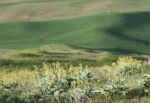Advertise Follow Us
Articles Tagged with ''no-tillers''
This program will recognize no-tillers that adopt economically viable, sustainable practices to protect the environment and add value to their grain crops.
Read More
Companion Cropping Boosts No-Till Profits, Soil Health
Growing double-crop sunflowers with multiple species has reduced inputs and enhanced primary crop health for Kansas no-tillers Robin and Kelly Griffeth.
Read More
Rolling, Crimping Can Help No-Tillers Use Covers Better
Well-designed roller-crimpers, and a good management plan, can help no-tillers and strip-tillers smother weeds, improve soil protection and get the most from high-biomass cover crops.
Read More
There’s No Competing With Long-Term No-Till
After jumping into no-till practices more than 2 decades ago, Iowa no-tiller Randy Caviness has been rewarded with more fertile soils, earlier planting and a stronger balance sheet to compete with neighbors.
Read More
Implement Guidance Paves The Way To Profitability
Technology that keeps field implements in line is gaining momentum as no-tillers and strip-tillers see increased yields, and lower input costs, through improved accuracy with field operations.
Read More
Gypsum Balances Nutrients, Builds Up Soil Structure
Proper applications of gypsum, an efficient carrier of soluble calcium, can help no-tillers improve the soil environment for plants and reclaim problematic sodic soils.
Read More
No-Tillers Tame Heat And Tough Clay Soils
Relay soybeans, controlled traffic and cover crops play key roles in helping Randy and Nicole Small make no-till work in southeastern Kansas
Read More
Top Mistakes, And Solutions, When Managing Precision Data
No-tillers can get more out of precision farming if they’re savvier about storing and protecting their data and interpreting it, says consultant Tim Norris.
Read More
Finding The Fertility ‘Gold Mine’ After A Dry Year
No-tillers could save inputs costs and raise yields by accessing residual nutrients in fields, but they need relevant data and must understand the factors that affect nutrient availability.
Read More










